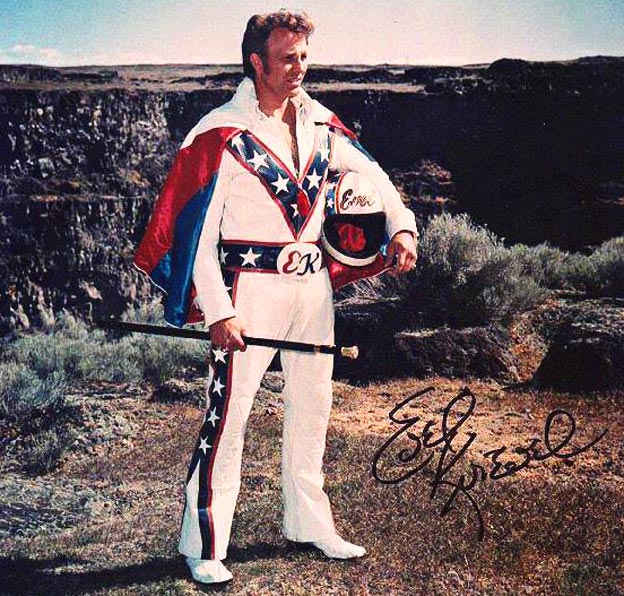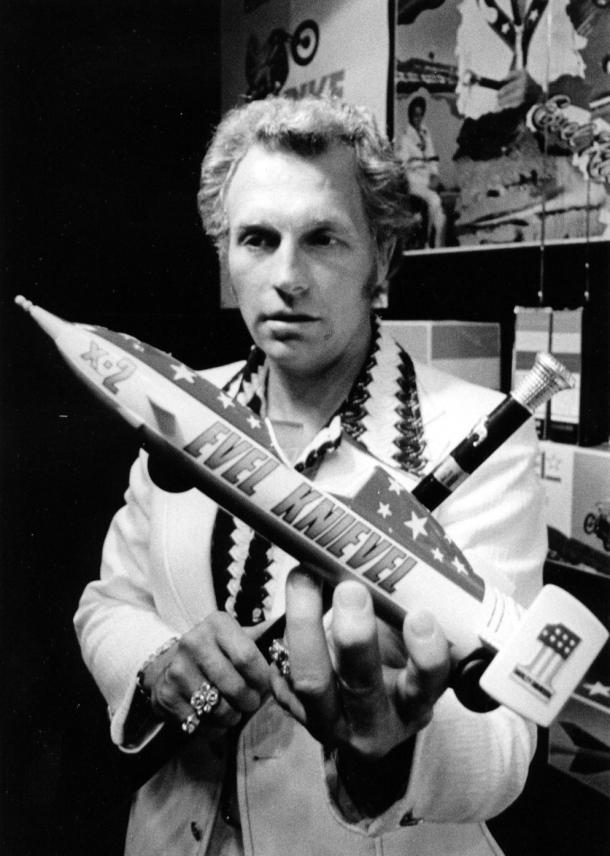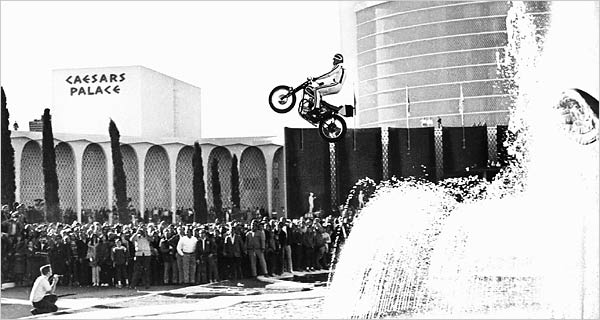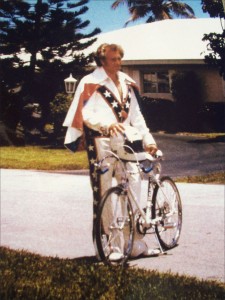How many bowls of cocaine were inhaled during the 1970s pitch meeting for this Evel Knievel crime drama pilot? The template for the A-Team, minus Dirk Benedict’s considerable gravitas.
You are currently browsing articles tagged Evel Knievel.
Tags: Evel Knievel
Evel Knievel was introduced to America in 1967, and six years later he was schmoozing with Johnny Carson as one of the most famous athletes in the world, provided you liberally define “athlete.” The ultimate alchemist, he turned trash into gold. Like a latter-day Houdini–but with nothing up his sleeve–the motorcycle jumper sold the masses on the possibility of death, just as many reality stars and celebrities do today with dysfunction and drugs.
Tags: Evel Knievel, Johnny Carson
Charles Fishman, author of The Big Thirst, nominates Las Vegas as the most water savvy area of the United States. It seems counterintuitive that a piece of desert crammed with swimming pools and gargantuan fountains could be considered water smart, but the city consistently makes it work despite meagre natural resources. An excerpt from his book at Marketplace:
“There is no two-mile stretch of ground anywhere in the United States that has such a density of water features, water attractions, and sheer water exuberance. Las Vegas, which can invest something as routine as breakfast with outlandish extravagance, has taken our most unassuming substance and unleashed it as the embodiment of glamour, mystery, power, and allure. In the way that only Las Vegas can, it has created a whole new category–ostentatious water.
The Las Vegas Strip is a demonstration of water imagination, of water mastery, and also of absolute water confidence.
It’s all the more remarkable because Las Vegas is the driest city in the United States. Of the 280 cities in the United States with at least 100,000 people, Las Vegas is No. 280 in precipitation and No. 280 in number of days each year that it rains. Las Vegas gets 4.49 inches of precipitation a year. And it rains or snows, on average, just nineteen days a year.
A metropolis with 2 million residents and 36 million visitors a year, Las Vegas gets ninety percent of its water from a single source, Lake Mead, the spectacular, man-made reservoir created on the Colorado River by Hoover Dam. When Lake Mead is full, it holds a sixty-year supply of water for Las Vegas.
But Las Vegas is legally allowed to take only a tiny sliver of Lake Mead water — 300,000 acre-feet a year, 98 billion gallons. All the water Las Vegas is allowed lowers the lake between two and three feet. Las Vegas’s allocation is about 4 percent of what everybody else gets to take from Lake Mead — 96 percent of the water people use from Lake Mead goes to either California or Arizona. And Las Vegas’s allocation is fixed in law, just as the allocations of California and Arizona are fixed — so the amount of water Las Vegas has access to hasn’t changed even as Las Vegas’s population has doubled, and doubled again, even as the city has added 100,000 new hotel rooms, along with fountains and waterfalls, swimming pools and shark tanks.”
••••••••••
Evel Knievel’s failed attempt at jumping the fountains at Caesars Palace, 1967:
Tags: Charles Fishman, Evel Knievel
Stunt cyclist Evel Knievel, destined for amazing fame but just an opening act at this point, makes his debut on Wide World of Sports in 1967.
Tags: Evel Knievel
Trash-sport legend Evel Knievel on kids’ show Wonderama in the 1970s.
Tags: Evel Knievel
Dick Cavett interviews Evel Knievel, 1971.
Another Evel Knievel post:
Tags: Dick Cavett, Evel Knievel
This week marks the 50th anniversary of Wide World of Sports, ABC’s great anthology program that introduced closed-in Cold War Americans to cities around the world, from Moscow to Monte Carlo, and made Muhammad Ali and Evel Knievel even bigger stars. And where else could you see frog jumping and drag racing and wrist wrestling in the same 90-minute span?
From ABC’s anniversary program in 1978:
“Spanning the globe to bring you the constant variety of sport… the thrill of victory… and the agony of defeat… the human drama of athletic competition… This is ABC’s Wide World of Sports!”
Tags: Evel Knievel, Muhammad Ali
I’ve long admired “He’s Not a Bird, He’s Not a Plane,” a fun profile of the late, great motorcycle daredevil Evel Knievel from the February 5, 1968 issue of Sports Illustrated. The piece was penned by Gilbert Rogin, a novelist who was also SI‘s managing editor.
The article relays what a sensation Knievel was in the ’60s and ’70s. He dressed like Elvis and escaped death like Houdini, although the dark side of his appeal was the sick fascination of watching what would happen if he couldn’t avert disaster, as he jumped his motorcycle over rows of cars, hotel fountains and actual rivers.
Knievel had none of the sociopolitical significance of Muhammad Ali, but he shared the boxer’s keen understanding of Hollywood, hoopla and the hard sell. He went through a lot of money, broken bones, personal problems, a rock opera and a late-life religious conversion before his death in 2007. In Rogin’s piece, Knievel touted his desire to jump across the Grand Canyon (which never happened). An excerpt about his not-so-successful jump over the fountains at Caesar’s Palace on the last day of 1967:
“On New Year’s Eve, Knievel jumped the ornamental fountains in front of Caesars Palace in Las Vegas, which are billed as the World’s Largest Privately Owned Fountains. Several weeks earlier he had said, ‘I know I can jump these babies, but what I don’t know is whether I can hold on to the motorcycle when it lands. Oh, boy, I hope I don’t fall off.’
Knievel’s fears were justified. Shortly after the motorcycle hit the landing ramp, he fell and rolled 165 feet across an asphalt parking lot. Knievel is now in Southern Nevada Memorial Hospital, recovering from compound fractures of the hip and pelvis. ‘Everything seemed to come apart,’ he said. ‘I couldn’t hang on to the motorcycle. I kept smashing over and over and over and over and over, and I kept saying to myself, ‘Stay conscious, stay conscious.’ But, hey, I made the fountains!'”
••••••••••
Knievel “jumps” the Snake River Canyon, 1974:
Tags: Evel Knievel, Gilbert Rogin




